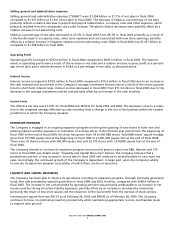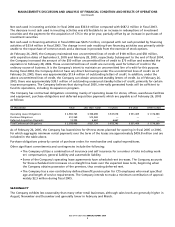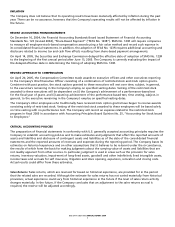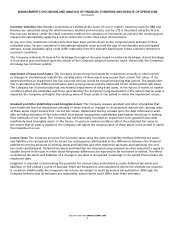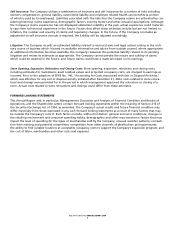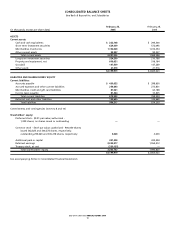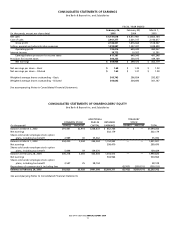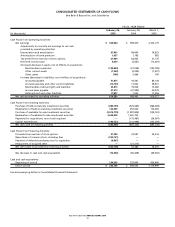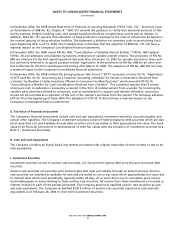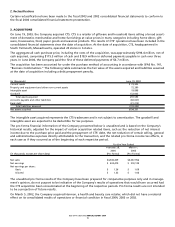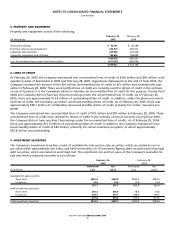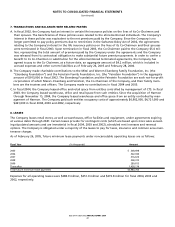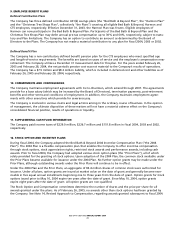Bed, Bath and Beyond 2004 Annual Report Download - page 17
Download and view the complete annual report
Please find page 17 of the 2004 Bed, Bath and Beyond annual report below. You can navigate through the pages in the report by either clicking on the pages listed below, or by using the keyword search tool below to find specific information within the annual report.
BED BATH & BEYOND ANNUAL REPORT 2004
15
All other investment securities are classified as held-to-maturity because the Company has the ability and intent to
hold these investments until maturity and are stated at amortized cost.
Premiums are amortized and discounts are accreted over the life of the security as adjustments to interest income
using the effective interest method. Dividend and interest income are recognized when earned.
J. Inventory Valuation
Merchandise inventories are stated at the lower of cost or market. Inventory costs for BBB and Harmon are calculated
using the retail inventory method and inventory cost for CTS is calculated using the first-in, first-out cost method.
Under the retail inventory method, the valuation of inventories at cost and the resulting gross margins are calculated
by applying a cost-to-retail ratio to the retail value of inventories.
At any one time, inventories include items that have been written down to the Company’s best estimate of their
realizable value. Factors considered in estimating realizable value include the age of merchandise and anticipated
demand. Actual realizable value could differ materially from this estimate based upon future customer demand or
economic conditions.
The Company estimates its reserve for shrinkage throughout the year, based on historical shrinkage. Actual shrinkage
is recorded at year-end based upon the results of the Company’s physical inventory count. Historically, the Company’s
shrinkage has not been volatile.
K. Property and Equipment
Property and equipment are stated at cost. Depreciation is computed primarily using the straight-line method over
the estimated useful lives of the assets (forty years for buildings; five to fifteen years for furniture, fixtures and
equipment; and three to five years for computer equipment and software). Leasehold improvements are amortized
using the straight-line method over the lesser of their estimated useful life or the life of the lease.
The cost of maintenance and repairs is charged to earnings as incurred; significant renewals and betterments are
capitalized. Maintenance and repairs amounted to $51.4 million, $44.5 million and $34.7 million for fiscal 2004, 2003
and 2002, respectively.
L. Impairment of Long-Lived Assets
The Company reviews long-lived assets for impairment annually or when events or changes in circumstances indicate
the carrying value of these assets may exceed their current fair values. If it is determined that an impairment loss
has occurred, the loss would be recognized during that period. The impairment loss is calculated as the difference
between asset carrying values and the estimated future undiscounted cash flows. The Company has not historically
had any material impairment of long-lived assets. In the future, if events or market conditions affect the estimated
cash flows generated by the Company’s long-lived assets to the extent that an asset is impaired, the Company will
adjust the carrying value of these assets in the period in which the impairment occurs.
M. Goodwill and Other Indefinitely Lived Intangible Assets
The Company reviews goodwill and other intangibles that have indefinite lives for impairment annually or when
events or changes in circumstances indicate the carrying value of these assets might exceed their current fair values.
Impairment testing is based upon the best information available including estimates of fair value which incorporate
assumptions marketplace participants would use in making their estimates of fair value. The Company has not
historically recorded an impairment to its goodwill and other indefinitely lived intangible assets. In the future, if
events or market conditions affect the estimated fair value to the extent that an asset is impaired, the Company will
adjust the carrying value of these assets in the period in which the impairment occurs.
Included within other assets in the accompanying consolidated balance sheets as of February 26, 2005 and
February 28, 2004 is $19.9 million for the tradename of CTS (see Note 2 - Acquisitions) which is not subject to
amortization.


